Here is a game for you to make. It is based on an old game called Happy Families which you may have played before.
To make the game:
You'll need:
- Five A4 sheets of thin card and/or paper
- Scrap paper or card (optional)
- Coloured pens or pencils
- Scissors
- Ruler
- Glue (optional)
- Sticky backed plastic (optional)
Divide each sheet of card into sixteen equal-sized rectangles like this:
Image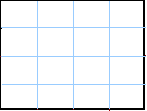
You may be able to do this by folding, otherwise by measuring. - You now need to design ten different pictures. They can be anything that you like, for example a car, a sweet, a boat, a house, an animal of some sort ... whatever you want. It would be a good idea to draw the outline for each design on a separate sheet of card and cut it out to use as a template.
Then draw around each of your pictures four times on the card so that your five pieces of card look like this:
Image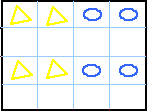 Image
Image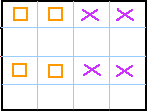 Image
Image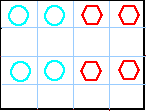 Image
Image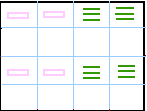 Image
Image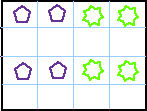
We've just used shapes to show where your pictures should go.
Using a black marker pen or thick felt tip, draw one dot under one of each picture, two dots under one of each, three dots under another of each and leave the other blank. Your card should now look like this:
Image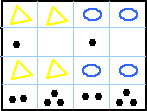 Image
Image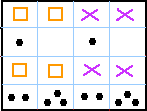 Image
Image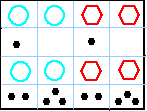 Image
Image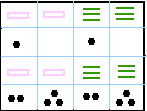 Image
Image
- If you want to, you could laminate your sets of cards. This would make them stronger and they will probably last longer.
Carefully cut out the cards so that each picture has a series of dots or a blank space underneath it. You should then have ten sets of cards like this:
Image Image
Image Image
Image Image
Image
Now you're ready to play.
To play the game: This game can be played with $3-10$ players.
You'll need a set of the cards you've made. Choose a group of cards with the same picture for each person. So, if there are five of you playing, you'll need five lots of cards - for example all the boats, all the teddies, all the balloons, all the drums, and all the elephants.
The aim of the game is to be the first to collect a set of four cards with the same picture - a 'family'.
How to play:
- Sort the cards into four piles. Make a pile of all the cards with no dots, a pile of all the cards with one dot, a pile of all the cards with two dots and a pile of all the cards with three dots.
- One player shuffles all the cards with no dots and deals them out so that each player has one of these cards. Another player shuffles all of the cards with one dot and deals them out, one card to each person. Another player shuffles and deals the cards with two dots, and another player shuffles and deals the cards with three dots.
- Each player should now have four cards, one with no dots, one with one dot, one with two dots and one with three dots - but they may all have different pictures.
- Choose a player to go first. He or she must decide which picture they would like to collect - it has to be a picture which they already have in their hand. They then choose a card that they don't want.
- They are allowed to exchange this unwanted card by asking another player for the picture card they do want which has the same value. For example, I may want to collect elephants. I have a teddy with one dot on it which I don't want. So I could ask one of the other players: "Do you have the elephant with one dot?"
- If the player who is asked does have that card, then he or she must exchange it and the person who asked has another go.
- If the person who is asked does not have the card, then nobody exchanges cards. The next player in the group is then allowed to ask someone for a card.
- The game goes on in this way until one person has collected their full set of four cards with the same picture.
You can make this game different by:
- Having to collect two sets of cards each
- Adding more cards to the families i.e. the same picture but with more numbers
You have probably got lots of ideas of your own as well.
Many thanks to Marian Bond for the idea for this Making Maths. For more of her ideas, look at the Fair Exchange problem and the article Money Problems? .
